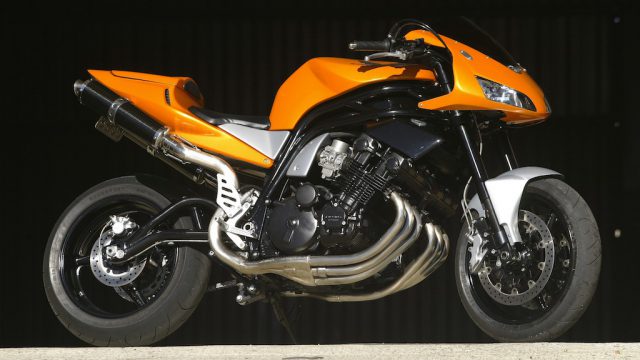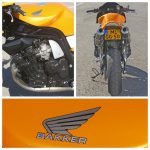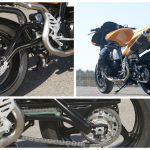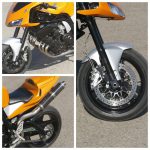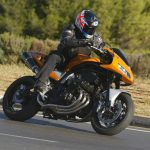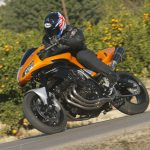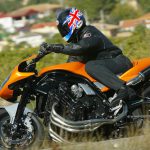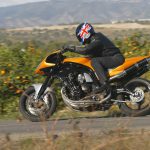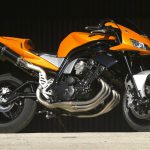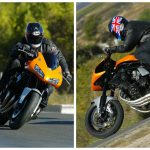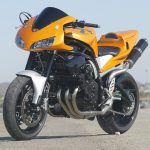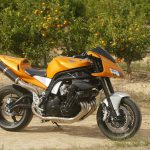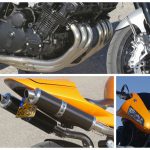A six-cylinder streetfighter powered by Honda’s classic CBX motor
Holland’s Nico Bakker is the couturier of chassis-builders, the welding-torch wizard who’s the man to consult when you want a high-class piece of hardware to wrap round a motor to create a unique bike that handles well and looks the business. So when a youthful Dutch enthusiast who prefers to remain nameless decided he wanted to cement his passion for the classic-era Honda CBX roadster, by creating a modern-day six-cylinder streetfighter that he could use to carve canyons and sweep streets around his home on Spain’s sunny Costa del Sol, there was only one man to turn to. The Bakker CBX Orange Blossom special resplendent in the Dutch national colours is the result – a unique tangerine dream-come-true that’s an inspiring blend of old and new, combining Nico Bakker’s timeless chassis skills with an iconic powerplant from all Honda’s yesterdays. Ancient meet Modern, to sire a sophisticated streetfighter with a retro heart.
Bike built in Holland’s national orange colour was ridden on an amber amble among the orange groves of Valencia at harvest time!
When it was launched on an unbelieving bike world back at the end of 1977, the Honda CBX represented a beat-that throw of the gauntlet by a company traditionally associated with leading-edge four-stroke engineering. For its air-cooled straight-six 24-valve 1047cc motor with central chain camdrive represented an imposing visual statement in producing 105 bhp at 9,000 rpm in understated but emphatic fashion – a package potent enough to propel an unfaired bike weighing a hefty 253kg up to a top speed of 225 kmh – all ground-breaking stats for the era, Moreover, it was designed by Honda’s high priest of Grand Prix engine technology, Soichiro Irimajiri, who in the previous decade had been responsible for such iconic racebikes as Honda’s world title-winning 250/350 sixes, and its five-cylinder 125, so this was a bike which had heritage as well as performance, As such, it’s not hard to imagine the CBX as a project close to the heart of the company’s founder, the late Soichiro Honda, then still very much a part of his company’s two-wheeled design strategy even as it expanded into the automotive sector.
You can also read: 2018 Triumph Bonneville Bobber Black Test
A closer look at the 2018 Dakar Rally line-up
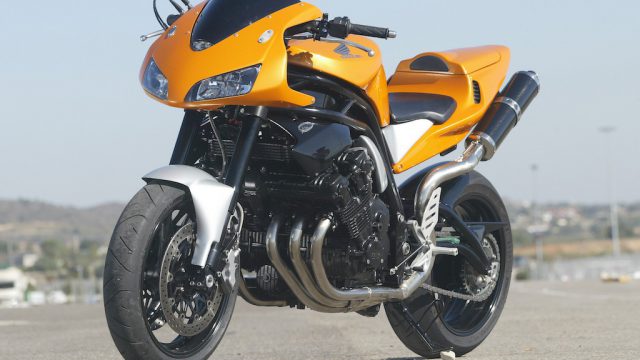
The 41,200 CBX sixes built in four versions from 1978-83 proved bulletproof as well as imposing, and during its six-year production run the model developed cult status for a core of enthusiasts who appreciated its straight-line performance as well as its silky-smooth power delivery and sibilant sound – especially when fitted with an aftermarket exhaust. That was what first got our Dutch dude smitten with the bike, the first time he saw one thirty-odd years ago. “My whole love affair for the six-cylinder Honda started when I was 10 years old,” he says. “I was walking with my mum in town, and I saw a CBX in front of a traffic light with the engine burbling away on idle. It had a 6-into-1 exhaust, and I couldn’t wait to hear it accelerate off – but my mother wanted to leave, and she was dragging me away. Then the lights changed and he took off, and the sound was just incredible – it made my skin shiver and my arms prickle, and I knew at once that one day I must have one of those bikes. It was a watershed moment I’ll never forget!”
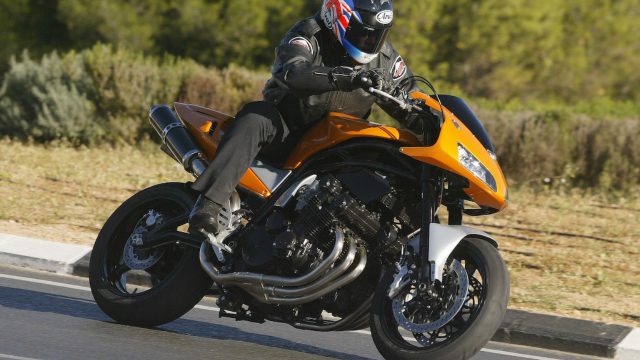
Years on, he made that dream come true by acquiring one of the final versions of the Honda six, an ’83-model CBX with bulky half-fairing and Pro-Link monoshock rear suspension. “I thought it was really ugly to look at, but it was all I could afford, and the engine was pretty good, even if it was smoking a bit because of a seized oil ring,” he recalls. “I ran it for a while, and then I decided to have Ruud de Groot rebuild it. He’s quite famous in Holland, because he worked for Honda Nederland for ten years and is a top expert on the CBX, and even drag-raced one. He rebuilt my bike’s engine with new parts, so then I had a new motor but an old, very ugly chassis. So that’s when I went to see Nico Bakker.”
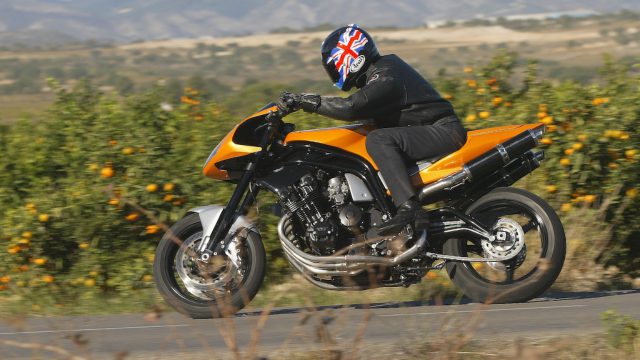
Dutch dude had grown up in the same neighbourhood as the late Jack Middelburg, the Netherlands’ legendary privateer GP racer with a fairytale story of rags to – well, if not riches, exactly, at least national acclaim, after he defeated the Japanese factory teams in 1979 on his Bakker-framed RG500 Suzuki to win his home GP at Assen in front of a quarter of a million fans. “I knew all the stories about how Nico Bakker made Jack’s bike and beat the Japanese with it, so I expected him to be a bit unapproachable,” he says. “But I was really in love with the CBX, and after I visited him in De Bakkerij (literally, the bike-bakery – Bakker means baker in Dutch!) a couple of times and discussed it with him, it was obvious Nico was the perfect person to help me create a modern CBX streetfighter that would be worthy of that fabulous engine. I really wanted a bike to go riding with, not for show, so safety and handling were important to me – looks came second. The frame had to be good, and it had to be fun to ride.”
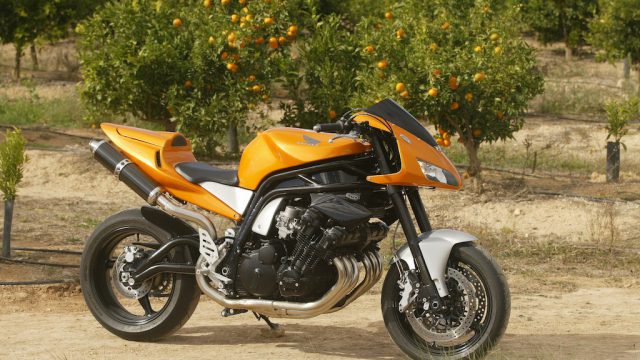
Perhaps inevitably, Nico Bakker had already built a half- dozen CBX-engined streetbikes in the 1980s, an endurance racer-style sportbike many of which are still in regular use today. “I know three other guys who have CBXs with Bakker frames, and years later they’re still happy with them,” says Dutch dude. “But I didn’t want a retro model like one of those – I wanted a modern bike with a comfortable seat so you can go long distances, and the engine had to really be a part of the design, too. That’s why we painted it black, so it was integrated with the frame to make it look smaller and less massive. I wanted a small fairing with good lights, not small ones like you usually get on a streetfighter, plus it had to be a single-seater, but with the option to have a passenger. And I didn’t want cables and tubes to be seen – the look had to be clean.” After a year of discussion on serial visits to the bike-bakery, Bakker began building the bike. Although by the end of that year it was almost ready, completion got held up while the customer moved to Spain – so it was actually finished off in the basement of his new home there. Since then he’s ridden it all over Spain, including each year to the Valencia GP, where he let me take it for an amber amble one morning into the neighbouring orange groves to try it out for myself.
Ancient meets modern, to sire a sophisticated streetfighter with a retro heart
Imposing but not encumbering, the Bakker CBX has plenty of presence when you first see it, a visual impression which perhaps surprisingly isn’t let down by the hands-on kind when you ride it. It’s not too tall, so it’s easy to climb aboard, and thanks to the slim 20-litre aluminium fuel tank crafted by Bakker’s metalwork magician Cees Smit, it rather surprisingly doesn’t seem too bulky on the move, even if you’re inevitably aware of that wide 24-valve cylinder head sticking out either side of the bike. This was one of the design imperatives for Nico Bakker, resulting in the narrow upper tubular steel frame from which the engine is hung as a fully-visible stressed member. “The chassis isn’t the lightest,” said frame-baker Bakker when I asked him how he did it, “but it’s made from 4130 chrome-moly tube with a 38mm diameter, so it’s plenty stiff enough for a heavy motor that weights 102kg with carbs. I based its geometry on the frame I made for my Grizzly streetfighter with a Suzuki GSX-R1000 motor, and I was surprised how well it looked when we got it finished. And it’s good to see the bike being used – I was a bit worried at first that my customer just wanted a showbike, but now it seems it’s a bike that gets ridden, which is nice.”
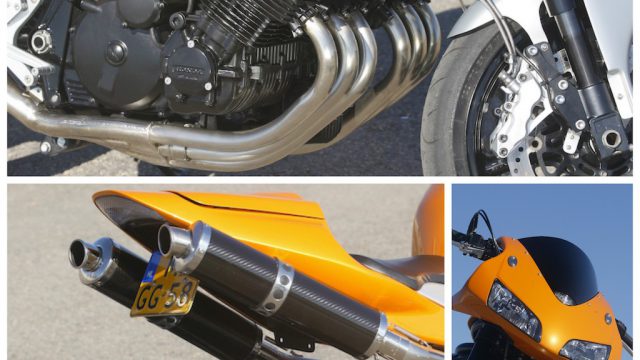
The finished product has a longish 1535mm wheelbase (quite rangy compared to the stock CBX’s 1498mm stride), but that’s compensated for by tighter steering geometry than the original, with the 43mm WP upside-down forks set at a 24-degree rake and delivering 120mm of stroke, with 98mm of trail, according to Nico’s notebook. But what’s most unusual is the far forward 57/43% weight bias delivered by the inclined six-cylinder engine package and the long wheelbase, with the distinctive-looking tubular steel swingarm operating a fully-adjustable WP shock via a Full Floater link providing 125mm of wheel travel. “I wanted to make sure the front wheel had lots of grip, and that the engine is mounted high enough to give enough ground clearance with the wide motor,” says Nico. “I didn’t ride it myself – so is it OK?”
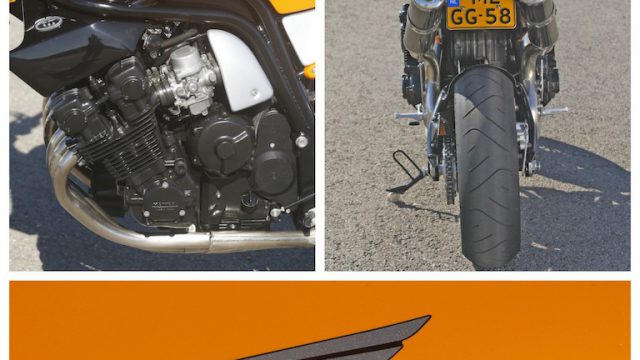
Well, rather surprisingly for a bike with such a massive motor, I think the answer is probably yes, though I’ll admit to being more cautious than usual in exploring the grip envelope of the set of Metzeler Rennsport treaded race rubber mounted on the Bakker CBX’s 2002-model Honda Fireblade wheels. That’s because grip on the dusty Spanish tarmac after a four-month Valencian summer drought wasn’t the greatest, so I didn’t truthfully explore whether it’s possible to scrape the engine cases or not, for fear of my Dutch mate not having a bike to ride another 780km back home the next day, and me to be on the receiving end of well-deserved Dutch dudgeon!. Anyway, this isn’t the kind of bike that you’re looking to drag your knees and/or the cases on in corners, even if that forward weight bias and the grippy Metzeler race rubber delivered pretty good turn speed for such a hefty piece of hardware. Instead, it’s a package that you’ll want to turn, point and squirt, revelling in the waves of syrupy torque and liquid horsepower as you crack open the throttle that’s surprisingly light-action in spite of having a total of six carbs to crank, and experience the six-cylinder engine’s purposeful rather than thrilling acceleration, that’s still impressive enough for a 40-year old motor.
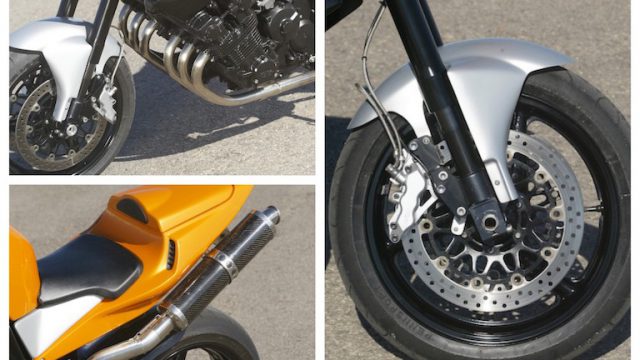
But that long ride from the Costa del Sol and back again wouldn’t have been too big a chore, thanks to the Bakker CBX’s pretty comfy seat, especially by the standards of the stripped-out streetfighter class, even if the riding position is a little too upright for speeds of more than 150km/h to be comfortable for long, and the footrests are positioned quite far back to avoid that hefty engine block. Still, the one-piece handlebar is ideally shaped – wide enough for good leverage in tight turns and traffic-clogged streets, where the easy clutch action and silky engine pickup make the wide six-cylinder bike surprisingly agile, and not at all daunting to ride.
As-new engine delivers 104 bhp at 8500 rpm, with silky-smooth power delivery and creamy performance to musical background of 6-2 Laser exhaust
The lovely liquid-feeling engine pulls cleanly away from the low 800 rpm idle speed without any transmission snatch, all the way to the 8,500 rpm power peak, where 104 bhp was delivered at the back wheel (versus the stocker’s 105 bhp at the crank) on the Mark Tronics dyno. This tuning shop in Holland run by former Ten Kate race engineer Maarten Fijlstra also supplied the only non-standard part on the Bakker CBX’s mechanical package, in the form of a specially-developed six-cylinder digital ignition which not only resolves the fact that stock CBX Honda CDIs have been unobtainium for some time, but also delivers more power, greater torque (90.2 Nm at 6,000 rpm, against 86.8 Nm with the original ignition), and a sharper throttle response with the same stock 28mm Keihin CV carbs, all with greater fuel economy. Sounds like the best of all worlds, and apparently Mark Tronics can develop a similar such package for any engine…..
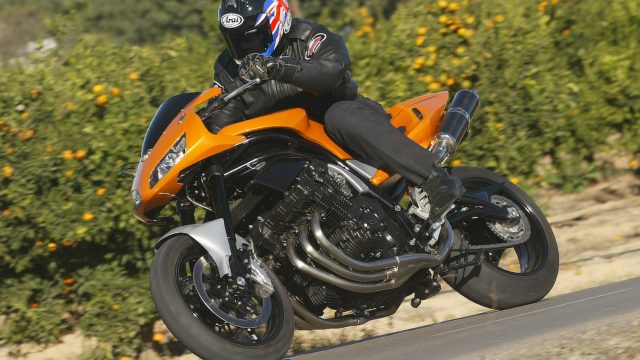
This creamy performance is delivered to the melodic, musical accompaniment of the custom-made 6-2 Laser exhaust’s twin carbon cans, matched to the sextet of Honda headers – more of a mellifluous burble, though, than the six-cylinder scream of an open-piped multi-cylinder GP racer. “I wanted to be able to ride the bike without earplugs, to enjoy the sound of the motor,” says the Dutch dude, who also admits to removing the mirrors he generally uses “because they look ugly for photos – but I suppose I’ll put them back for the ride home!” The small fairing is actually the top half of a ’04-model CBR600RR’s bodywork, complete with stock Honda headlamps and a rectangular dash housing French-made Mode 7 digital instruments displaying speed, rpm, oil temp, mileage and trip which is all pretty legible, but not at a quick glance. You must study it hard to get needed data, and by then you’re about to miss your apex or stray off-course – just needs to be bigger, that’s all. The Bakker CBX’s archaic ‘80s switchgear is at odds with this digital 21st century dash – it makes you realise how the world of components has moved on in the past four decades.
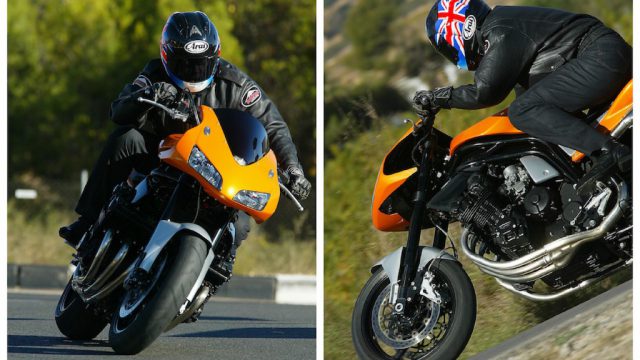
In recognition of that fact, Dutch dude has fitted late-model Honda Fireblade brakes to his six-cylinder streetfighter – but the result was surprisingly disappointing, with not a lot of bite from the massive 330mm front discs and their six-piston Nissin calipers. For sure he must be using the wrong pads, because I know from experience these brakes will stop a truck – instead of which, when you squeeze hard on the Bakker CBX front brake lever, there’s a very un-confidence inspiring loud graunching noise, but not a lot of retardation, and using the single-piston 280mm rear brake makes no difference – it’s almost useless. For a point-and-squirt package like this that’s a major defect, which really needs attention. Pity, when the rest of the bike is dynamically pretty satisfying in real world riding conditions, as well as great to look at.
Upright riding position is comfortable and commanding, without any sense of excessive bulk
I guess final attention to detail like this underlines that what we have here is essentially a high-class special, built around a Bakker frame kit that’s as fine-handling and ready-steering as any of Nico’s numerous designs. But it’s been finished off by an enthusiastic owner, rather than finely honed and the edges smoothed off in the bike-bakery. Well conceived, well executed and essentially well finished, the Bakker CBX is a completely unique ultrabike that’s fun to ride, and evidently gives satisfaction to its owner. “Now I have the bike running well at last, I’m totally in love with it – even if it’s taken ten years and 35,000 Euros to create it,” he says. “But it’s a unique bike made just the way I wanted it to be, to my specification and taste, but with Nico’s skills. Sometimes, there had to be a compromise if I wanted something and he said it couldn’t be made, but the bike itself wasn’t compromised too much – it’s basically just how I wanted it to be. I get a lot of fun riding it, even if I sometimes must be careful trying to squeeze through traffic to follow my girl-friend on her Triumph Speed Triple.” Must be a male thing, having twice as many cylinders as your partner….
